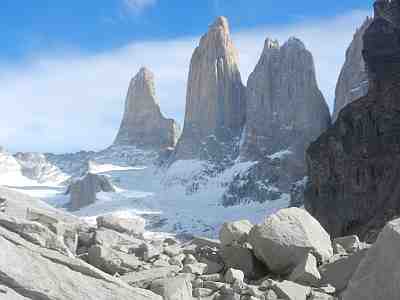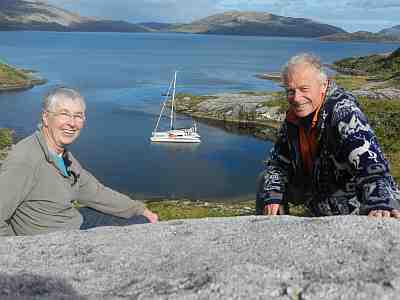51 34S 74 05W
14 March 2014
Dear friends,
The weather has been our constant preoccupation as we move between calms and gales, very cold into less cold, and through rain, wet snow, thick cloud, and sunny patches. From the Beagle Channel we proceeded west and briefly saw the Drake Passage from Passo Oriental, with gentle swell from the Southern Ocean, into the Canal Cockburn, and thence to the Magellan Straits and towards the west and north. Having rounded the bottom of them, we crossed back through the Andes at sea-level with magnificent blue-white glaciers on either side. Arriving at Puerto Natales at the edge of the Patagonian flat steppe which leads across Argentina back to the Atlantic. There, we restocked with fuel fresh food and drove to the famous Torres Del Paine rock spires.
Rainbows, penguins, dolphins, albatross, spouting whales and leaping seals (they seem to act like dolphins) are some of the things we spot as we pass. On land we have watched guanaco, foxes and Nandu (Rhea) an ostrich like bird.
Each little cove and anchorage which we stopped at is different, but Jan & Dave got into a working routine: approaching the bay, letting down the dinghy, lifting on the outboard engine on & starting it, then manoeuvering Dulcinea into position, dropping her anchor, and using the dinghy to tie any shore lines as needed to trees from the the 2 reels with 200 metres each of floating polypropylene line.
The scenery is spectacular. One difference between here and British Columbia may be the size & the isolation of it all. Our human contact for 3 weeks was to identify ourselves by radio to 3 lighthouse-keepers, chat on the radio to one other sailing boat in the Magellan Strait, and to spend one evening talking to a couple whom we met on a beach where we anchored in a small inlet. Otherwise we have waved cheerfully to 3 or 4 passing fishing boats.
Dulcinea's systems have mostly worked well. Our 50Kg Roccna anchor has dragged a couple of times but only when fouled in weed and while the boat has been pummeled by gales at the same time. Just the oven on our Force ten stove has been so difficult to keep lit that we have changed from baking bread in the oven to making it in the pressure-cooker. We have read about pressure-cooker bread but never made it before, and it seems to reliably work well....An update on bread making. Up to now Jan has been the baker. Today, Dave baked his first pressure cooker loaf, took it out to the cockpit to scrape some black off the bottom, and dropped it in the sea. We are happy to say it floated and was retrieved by dinghy, washed and is now being eaten with peanut butter.
Confessions must be made, and in Caleta Notch, off the Magellan Strait the forward-looking sonar (FLS) gave us not quite enough warning to stop before an upcoming rock. We ran onto it on a falling tide and had to wait for the next high water to float off. Dulcinea was actually pinned on the FLS transducer, otherwise she would have slid off straight away, but the transducer seems to have been the only damage. Dave did don a wet suit to apply some underwater epoxy round it, and yes the water was still cold.
>From various anchorages, we have had lovely walks up the hillsides. At first, these were in scrubby woodland, but as we moved west, the vegetation became increasingly scant, with mossy granite slopes. Trees give a reliable indication of the strength of the prevailing wind, and sheltered coves are well indicated by tall trees. Similarly, most underwater rocks can be seen by the fronds of kelp that float up from them.
7th March, Jan & Dave slept through a quiet peaceful night in Caleta Delano off a salmon farm, then motored to Puerto Natales next morning. Through the morning the wind strengthened, and we arrived up to the only tenable anchorage 6 miles up the low fjord at the Estancia Eberhardt with 40 to 50 knots of wind and 3 to 5 metres of water-depth registering on our instruments. Our helpful book tells us that 40 to 50 knots is Strong Gale to Storm force, which may blow off chimney pots, blow down fences, or uproot trees. Thankfully no trees came hurtling past us at critical bends in the fjord! It felt good to have 2 engines running - enough to power into the wind, and backup in case one gave any trouble at a critical moment.
Now 2 days north and west of Puerto Natales, we are anchored in "Caleta Moonlight Shadow" where a natural rift makes a 2 mile channel into the island. It is only 30 to 50 metres wide. Not a thing is moving here except for the flying steamer ducks and kelp geese.
Sunshine today, and for a while we were sailing at over 10 knots, but tomorrow forecasts fresh northerlies so we shall probably go for a walk across the island to peek at the Pacific Ocean.
Best wishes to all from
Jan & Dave on Dulcinea

